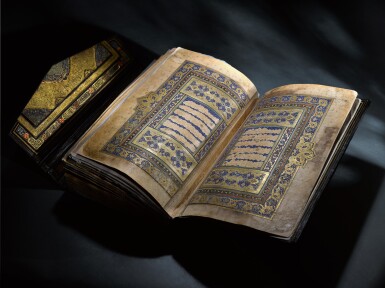Arts of the Islamic World & India including Fine Rugs and Carpets
Arts of the Islamic World & India including Fine Rugs and Carpets

A magnificent illuminated Qur'an written in gold, Persia, Herat, Safavid, third quarter 16th century
Auction Closed
October 27, 03:41 PM GMT
Estimate
300,000 - 500,000 GBP
Lot Details
Description
Arabic manuscript on paper, 268 leaves plus 2 fly-leaves, 14 lines to the page, written in elegant naskh script in gold ink, diacritics in black, verses separated by gold and polychrome roundels, surah headings in white cursive script on gold and polychrome illuminated panels, margins ruled in gold and polychrome, later catchwords, illuminated marginal devices throughout, khamsa and 'ashr marked with white Kufic script in illuminated marginal roundels, hizb marked with illuminated cusped medallions, opening double page illuminated in colours and gold with 6 lines of gold naskh text in clouds on reserved ground, in contemporary Safavid stamped leather binding decorated with scrolling vines, with flap, the doublures with gilt and stamped scrolling decoration, the central medallion, corner-pieces and borders with fine découpe gilt arabesques on a polychrome ground
36 by 25cm.
Christie's London, A Private Collection Donated to Benefit the University of Oxford, Part V, 10 April 2014, lot 15.
The tradition of using gold for writing Qur’ans dates from the early medieval period of the Islamic world but very few complete manuscripts exist. One of the earliest and most important manuscripts of the Qur’an, commonly known as the ‘Blue Qur’an’, is written in gold Kufic script on blue vellum. Dated to the ninth century, the exact origins of the Blue Qur’an have not been firmly established and it has variously attributed to Andalusia, North Africa and the Near East. For two leaves from the manuscript which were sold recently in these rooms, see 27 October lot 404 and 22 April 2015, lot 62.
Examples of manuscripts written in gold naskh and thuluth on paper are known from the Fatimid period in Egypt (the first volume of a two-part Qur’an, dated 1028 AD), and from the Ilkhanid period in Iraq (sections of a Qur’an juz’ commissioned by the viziers Rashid al-Din and Sa’d al-Din for Uljaytu, dated November 1310), both in the Museum of Turkish and Islamic Arts in Istanbul and published in Farhad and Rettig 2016, nos.14 & 24. Another rare example of a Qur’an leaf written in gold Maghribi script on parchment, dating to the thirteenth/fourteenth century from Marinid Morocco or Nasrid Granada, sold in these rooms as part of the Stuart Cary Welch Collection, 6 April 2011, lot 7. Further manuscripts are in the Nasser D. Khalili Collection, London, including two Qur’an sections from Persia dated to circa 1320-30 and 1334 written in gold rayhani script, and a single-volume Mamluk Qur’an dated to 1382-83 in gold muhaqqaq script (see James 1992, nos.26 & 27, pp.114-9; no.47, pp.190-3).
Luxurious volumes written in gold script are also known from the Ottoman period. A single-volume Qur’an dated circa 1470, intended for the Ottoman Sultan Mehmed II (r.1444-46; 1451-81) and transcribed entirely in gold thuluth, and another dated to 1517, from the mausoleum of Sultan Selim II (r.1566-74), are published in Farhad and Rettig, op.cit., nos.54 & 55. It is worth noting that in the aforementioned manuscripts, the gold script is outlined in red or black ink, unlike the present manuscript which is written in gold without an outline.
